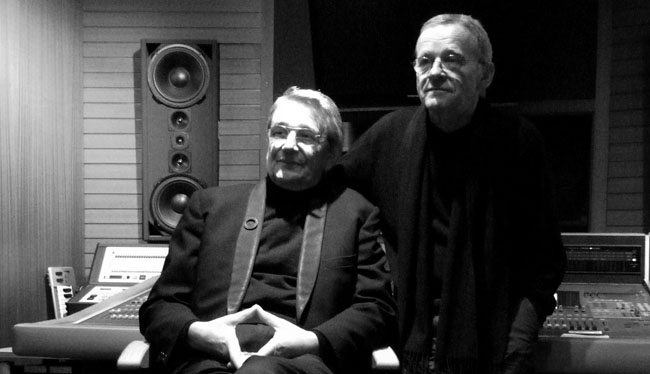This article is more than 1 year old
I'm sooooo green: The Beginner's Guide to Krautrock
'We’re not musicians, we are universal dilettantes'
What makes Krautrock rock?
Krautrock is an affiliation held together more in time, space and attitude, rather than any musical style or genre. The music emerged at the same time as affordable synthesisers, so early analogue classics such as the Moog, Mellotron and EMS Synthi feature heavily on many recordings.
Yet Krautrock’s great strength is that it is without rules or limitations, the greatness of The Cosmic Jokers' albums lies in the mad mix of folkies and synth pioneers. Sound engineers and producers such as Conny Plank and Dieter Dierks developed a spatial sound of their own, heavy on the phasers and delay. But the artists relentlessly pursue their own thing and that (when it works) has made the greatest of the music epic and timeless.

The irrepressible Conrad Schnitzler
Although the golden age of Krautrock was definitely the 1970s, some major work has been completed since. What really did for the genre was the same which did for the classic era of Dub Reggae: the digital age. Both are essentially analogue arts and when you add too much machine automated perfection, the spell is broken, the music becomes something else, new age or techno.
The artists who survived were those able to diversify: Roedelius into his Satiesque Piano Impromptus and sound canvases, Moebius and his dub collaborations, Schnitzler with his endless experimentation. Some, like Faust, sat out the digitally obsessed 1980s and came back in the more anything goes '90s. Some made hideous new age albums, others completely weirded out. What follows are examples of some of the better later diversifications.
Herr Distein’s Discs of Delight
Roedelius – Geschenk Des Augenblicks (Gift Of The Moment), Bureau B. Probably the best of Hans-Joachim’s early piano-based albums from the 1980s, though some prefer Lustwandel – both just remain on the credible side of fromage and have been recently reissued. You can even get it on iTunes.

Roedelius by Roedelius
Roedelius & Story – Inlandish, Grönland (2007). Tim Story applies an Enoesque wash to spacious Roedelius piano. Dwells in a similar spacetime as the classic: Cluster & Eno.

Moebius, Plank and Neumeier – Zero Set (1983), Bureau B. One of the last great productions of Conny Plank who adds his unmistakeable touch to Neumeier’s hypnotic drums and Moebius’s bubbling electronics. This collaboration is also available on iTunes. Moebius and Neumeier completed the only slightly less interesting Zero Set II in 2007, including a tribute to the since deceased Plank.
Moebius and Tietchens – Moebius + Tietchens, Bureau B. One of the more interesting of Dieter Moebius’s many collaborations released in 2012, Asmus Tietchens has had a long career in electronica and his minimal style complements Moebius well. Available on iTunes.

Moebius+Tietchens – photo by Irene Moebius
Roedelius & Schnitzler – Acon 2000/1, Captain Trip Records. Issued in a limited edition of 500 and thus tricky to locate this work is the final collaboration between two original members of Kluster, after 30 years. Roedelius gets weird and Schnitzler gets classical. A landmark, virtuoso recording in a world of its own. I’ve been making electronic music since the mid-1980s, and I can’t tell you how they do it. If you can wait long enough, I imagine Bureau B will re-release it sooner or later.
Conrad Schnitzler – 00/830 EndTime, M=minimal. Schnitzler’s final work, completed days before his death in 2011. The culmination of Con’s prolific output and a great place to start with Schnitzler’s later work. All 36 tracks are available for download on iTunes.

Kosmischer Laüfer – The Secret Cosmic Music of the East German Olympic Program 1972-83, Unknown Capability Recordings. These tracks by Martin Zeichnete amount to being the best Krautrock tribute band. Zeichnete, a massive Neu! fan, constructed this Ersatz Ostkraut music in East Berlin between 1972-83 to accompany the East German gymnastic team to use for warm-ups and displays. The results were released a couple of years ago and while nowhere near as far out as the original Neu! albums, they are a lot better than most of Herrs Dinger and Rother’s 1980s output. The first album, in particular, is well worth a listen and can be found on iTunes. ®
Andrew Orlowski's Teutonic Taster
Walter Wegmüller: Die Welt. The New Age mystic recorded the LP Tarot with Ash Ra Tempel as his backing band. About as funky as Krautrock ever got.
Moebius & Beerbohm: Subito from the album Strange Music (1982). The Cramps drummer gets stuck in a lift with a Giant Mutant Fly! These Kraut alumni kept the flame going into the 1980s, this one inspiring early industrial music.
Amon Düül – Love is Peace Warning: three minutes of audio from this (from the neglected first incarnation of Düül) YouTube clip and you might need to wash the reek of Patchouli oil and smoke from your clothes. Still, nothing captures the utopian commune vibe of the era like this one. "Freedom is harmony" – how very German.
Manuel Göttsching: E2-E4. Ash Ra Tempel's guitarist accidentally invents House and Ambient Techno in his first solo record, astonishingly recorded in 1981. The Balearic keyboards are actually processed guitar. As you'll probably notice, this album has been widely sampled.
